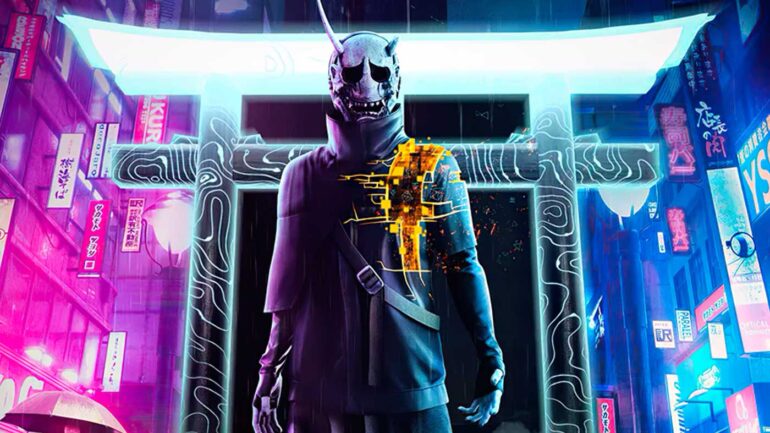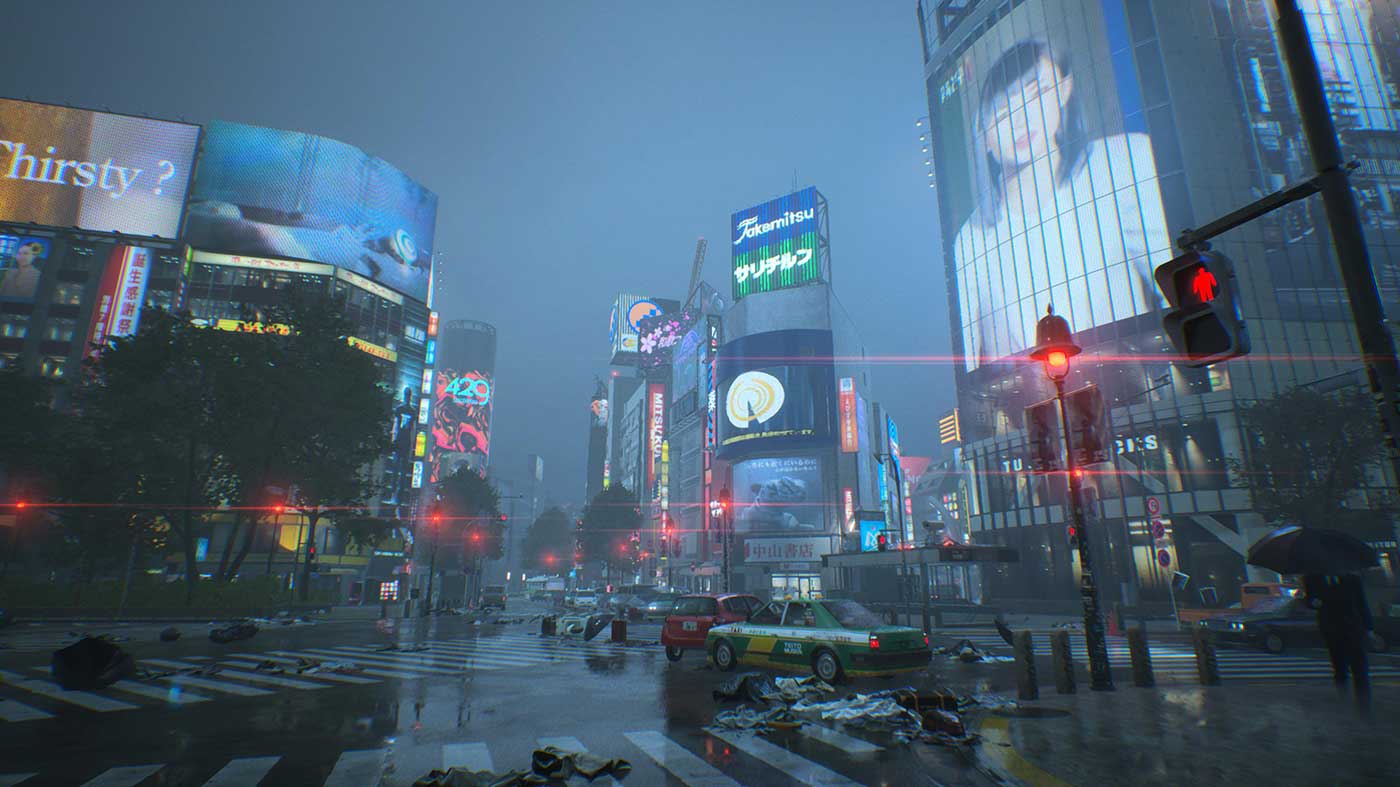Ghostwire: Tokyo is a series of firsts for Tango Gameworks. It’s the first game since their debut with The Evil Within eight years ago to not be a pure horror game. It’s also the first time the team has presented their game in first person. But most overwhelmingly, it’s their first-ever open-world game. I was skeptical whether the team could make a city as densely compelling as the more wide-open worlds we’re used to seeing in other games. Still, I’m happy to say that Tango has nailed it. Ghostwire: Tokyo is a fun open-world experience, though that does come with some caveats.
THE CHEAPEST COPY: $78 WITH FREE SHIPPING AT AMAZON
In Ghostwire: Tokyo, you play Akito, a man who has been in a traffic incident and, in his final moments, is possessed by a spirit hunter calling himself KK. KK imbues Akito with supernatural powers and offers him an ultimatum – help him stop the person responsible for this, and KK will help Akito save his sister, who has been taken hostage by a mysterious man named Hannya. It’s a basic story that’s presented in a rather bizarre manner, but despite all the twists it throws at you, I found it hard to be satisfied by the ending. It wasn’t bad, mind you, it just happened, and I didn’t feel anything.
As alluded to in my preview earlier this month, Ghostwire: Tokyo is Tango’s first truly open-world game. You’re thrown into a map comprising main missions, side missions, and more minor activities. The difference here is that the world of Tokyo presented in Ghostwire is relatively dense, so the open world isn’t vast, overwhelming, or unmanageable. Another key difference is the way combat is done, using an assortment of talismans, charms, and unique spells to destroy the enemies you come across in the city. The running theme throughout Ghostwire: Tokyo is thusly so; it does what every open-world game has already done but in such a uniquely compelling way that it doesn’t feel as trite as it should.
The combat itself is the heart of the experience with Ghostwire: Tokyo. Called Ethereal Weaving, it allows Akito to manipulate the elements to defend himself from the otherworldly visitors that Hannya has summoned. The three major powers you have behave similarly as weapons would in other games. The wind spell is a quick, handgun-like projectile, and the fire spell is a heavy and piercing explosive, while the water spell is better for groups and up-close, like a shotgun. Each of them has a more appropriate use in battle, depending on how the enemies swarm you. However, charms and talismans can be used to stun enemies and facilitate stealth options if you so wish.
You can attempt to play Ghostwire: Tokyo from a stealthy perspective. Akito also acquires a bow and arrow early on, allowing him to take down enemies without alerting others. In my preview, I’d hoped these mechanics would see some expansion beyond the arrows you get in the opening hours, but it remains the same from beginning to end. Other charms and talismans can be used to distract enemies or even spawn vegetation to hide in, so there are options that encourage stealth too, but the bow and arrow feel undercooked as a mechanic.
The enemies you’ll be fighting come from a nice pool too. While many of them are all different-looking humans, they all serve different purposes in battle. Some of them are more prone to rushing you down, while others will stand back from a distance and pelt projectiles at you. Ghostwire: Tokyo’s combat shines when it’s throwing all kinds of enemies at you, and you have to manage them effectively with the spells and gear you have on hand. But what’s even better is when it throws one of the few non-human enemies at you. These demons really feel like rejects from The Evil Within with their grotesque appearance and stranger abilities, with some even being able to separate Akito from KK.
There are moments when Akito and KK are separated, either for story purposes or during combat. During combat, it’s stressful but usually manageable enough to just return to wherever KK’s spirit is and reabsorb him. In my preview earlier this month, I was worried that the separation forced on the player during the story would get old fast. Thankfully, it doesn’t happen anywhere near enough to become a problem during the main story path, which is a relief.
There’s a handful of boss encounters that you’ll be thrown into as the story progresses too. Much like the enemies themselves, these are inspired by yokai but given a bit of a twisted visual update to better suit the vibe Ghostwire is going for. These boss battles are pretty standard – you just pelt them with spells until they die – though one of them is more of a stealth encounter which I particularly enjoyed. That being said, I’d have appreciated if there was a little more to these beautifully macabre creatures than just wailing on them until they died.
I think that’s the thing about Ghostwire: Tokyo that stands out the most. A lot of the combat doesn’t feel very nuanced, as almost every encounter just has me scrolling through my powers and throwing them out there until everything is dead. Like I’ve mentioned before – perhaps it would’ve worked better if some enemies were weak to a specific element or if the enemy design was done so in a way that required certain powers. It’s a fun combat system; there’s just not much to it.
What really separates Ghostwire: Tokyo is how much of a joy it is to get around the city. From the get-go, you’re given the ability to grapple to the roof of the buildings of Tokyo wherever a tengu (a type of yokai – more on those soon) appears. Later on, as you upgrade your abilities, you can grapple up to almost anywhere. Add a very generous glide mechanic and a distinct lack of fall damage and getting around Tokyo is just one of the many reasons Ghostwire: Tokyo rarely feels tedious even when you’re doing something as basic as climbing.
Thankfully, the side missions are just as compelling as the main story missions. Each of them is usually tied to a yokai – a kind of friendly spirit pulled from Japanese folklore. Usually, you’ll work with the yokai in a side mission to solve some small dilemma and be rewarded with collectibles that will enhance your skills. That being said, the design of these side missions admittedly feel like side missions. Many of them have you sneaking up on someone or moving somewhere to find an item, or being transported to an arena to take down enemies. They are, once again, nothing new for a game of this style, but the stories and activity types are varied enough to keep things interesting.
Other less elegantly executed optional content comes in the form of the many collectibles strewn throughout the city. Spirits can be absorbed and then exchanged for skill points throughout the city. Shrines can be prayed at to increase the maximum storage amount or your ethereal weaving spells. You can even find items and exchange them for currency at the games many floating cat shopkeepers. These aspects of the game will undoubtedly give players more to do but feel the most by-the-numbers in terms of their design and implementation – they’re incessant (but not compulsory) busywork.
Suppose you decide to do absolutely everything in Ghostwire: Tokyo. In that case, you’d probably find yourself spending around twenty to thirty hours doing so, depending on how efficient you are. The main story took me about fifteen or so hours, but I did many side quests early on in the game. Other difficulty levels offer a bit more of a challenge, too, including one that see you run through the game without upgrades, but this feels like a traditional one-and-done single-player experience.
Without a doubt, however, Ghostwire: Tokyo is a visual feast for the eye. The neon-lit cityscape of this alternate world Tokyo is gorgeous – seeing the lights hit the wet pavement with raytracing is one of those experiences that you can’t get anywhere else but the new consoles. The creature and yokai designs are all uniquely charming, and it all comes together to offer a world that’s truly unlike anything in any other game. The music is similarly fantastic, adding that Japanese flair to an already strong and pounding dramatic score.
Ghostwire: Tokyo is a bizarre game – on paper, it sounds rather unremarkable. But in practice, everything comes together so wonderfully to offer an open-world experience where its similarity to other games is quick to fade.











